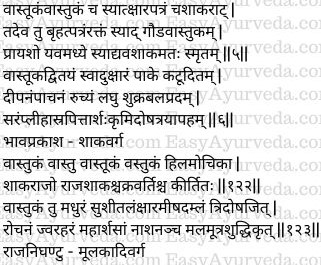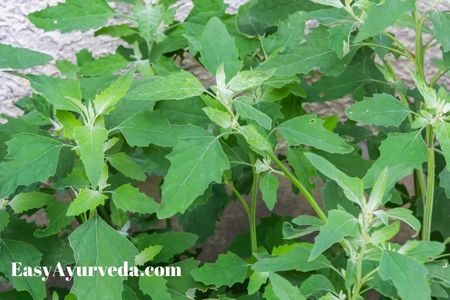By Dr Renita D’Souza
Chenopodium album is an Ayurvedic medicinal plant known by Sanskrit term “Vaasthooka” is widely used in spleen disorders, rheumatism, dysentery, bleeding piles, bug bites, sunstroke, burns, urinary problems, worm infestation, skin problems, intrinsic haemorrhages etc. As it is usually found in the fields hence it is termed as “Yavashaaka” in Sanskrit. It is a natural coolant and thus useful in high pitta dosha conditions. It is considered as heart tonic and also used to improve hemoglobin level.
Read – Mexican Tea – Chenopodium ambrosioides Uses, Research
Introduction
Botanical Name – Chenopodium album
Family – Chenopodiaceae
Medicinal Qualities
Taste (Rasa) – Madhura (sweet)
Vipaka (Taste after digestion) – Katu (pungent)
Guna (Quality) – Laghu, Kshaara, Sara
Action (Karma) –
Deepana – carminative
Digestive – digestive
Ruchya – appetizer
Shukra prada – increases sperm count
Bala prada – improves physical strength.
Read – Amaranth Uses, Qualities, Remedies, Research
Remedies
- Bleeding piles – Vastuka (Chenopodium album) plant is consumed as vegetable along with goat milk.
- Stomach pain – Tea prepared from dry / green leaves of bathua is consumed to get relieve from stomach pain.
Pharmacological Activities
Chenopodium album possess anthelmintic, antiphlogistic, antirheumatic, antidiarrheal, antioxidant, antimicrobial, contraceptive, laxative, odontalgic etc.
Nutritional Values
Chenopodium album leaves contain various nutrients such as protein, fat, fiber, minerals and vitamins. It is also a good source of iron and calcium.
Effect on Doshas
Tridoshahara – balances all three doshas
Therapeutic Uses
It is indicated in
Pleeha – spleen disorders
Rakthapitta – bleeding disorders
Arsha – piles
Krimi – intestinal worms
Part used
Whole plant, Leaves
Read – Thorny Amaranth – Tanduliyaka Uses, Qualities, Remedies, Research
Sanskrit Verses

Botanical Description
Chenopodium album is an erect herb growing up to 3.5 meter in height. Leaves are simple, entire, oblong or lanceolate, obtuse or acute. Flowers are arranged in clusters in spikes. Fruits are enclosed in the perianth. Seeds are smooth, shiny and compressed.
Distribution
Chenopodium album is found throughout the world mainly in India, North America, Northern East and Europe.

Varieties
According to Bhaavaprakaasha Nighantu, there are 2 varieties of vaasthooka.
One which has big leaves and red in color is termed as “Gowdavaasthuka”.
Chemical Constituents
Chenopodium album has various phytochemicals like alkaloids, phenols, saponins, phytosterols, and flavonoids.
Research
Anti-inflammatory Activity – A research study ‘Chemical constituents and anti-inflammatory activity of leaf essential oil of Nigerian grown Chenopodium album L.’ have showed that the anti-inflammatory action of the oil is concentration dependent.
Classical Categorization
Bhaavaprakaasha Nighantu – Shaaka varga
Raja Nighantu – Moolakaadi varga
Scientific Classification
Kingdom: Plantae
Division: Magnoliophyta
Class: Magnoliopsida
Order: Caryophyllales
Family: Chenopodiaceae
Genus: Chenopodium
Species: album
Vernacular Names
Sanskrit Name – Vaastuka
English Name – Fat Hen, Lamb’s-quarters, Pigweed
Hindi Name – Bathua
Kannada Name – Kaduoma
Bengali Name – Chandanbethu
Malayalam Name – Vastuccira
Konkani Name – Chakvit
Tamil Name – Paruppukkirai
Telugu Name – Pappukura
Oriya Name – Bathua
Unani Name – Bathuaa, Baathu
Read – Radish Benefits, Usage, Dose, Side Effects
Sanskrit Synonyms
Vaasthooka, Vaasthukam, Kshaarapatra, Shaakaraat
Vaasthu, Hilamochika, Shaakaraaja, Raajashaaka
Chakravarthi

